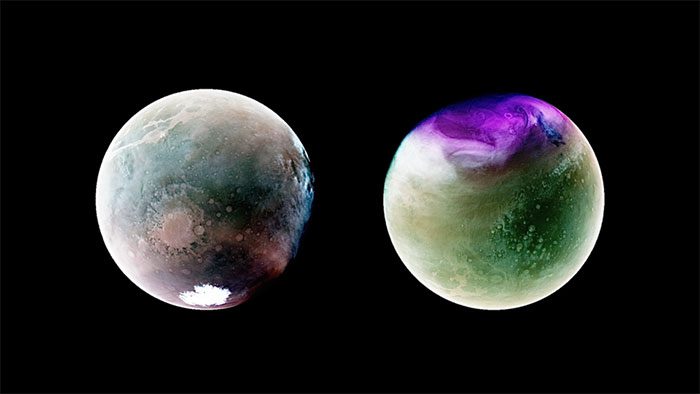New images of Mars provide intriguing new perspectives, allowing scientists to gain further insights into the seasonal changes of this planet.
According to Space Magazine, astronomers have used NASA’s Mars Atmosphere and Volatile EvolutioN (MAVEN) spacecraft to capture stunning new images of the “Red Planet.” The spacecraft is equipped with an Ultraviolet Spectrograph (IUVS), which can measure wavelengths ranging from 110 to 340 nm, a range beyond the visible spectrum that can be seen by the naked eye.

NASA’s MAVEN spacecraft captures an image of Mars in ultraviolet light. (Photo: NASA).
The purple regions of the image represent ozone in the Martian atmosphere, while the white and blue areas depict clouds or fog. The surface of the planet appears brown or greenish in the new images.
“By observing the planet in ultraviolet wavelengths, scientists can gain a better understanding of the Martian atmosphere and study surface features,” a NASA representative stated on June 23.
The images shared by NASA on June 22 were taken when the planet was near two opposite ends of its orbit around the Sun. Like Earth, Mars rotates on a tilted axis, which causes it to experience four distinct seasons.
However, the seasons on Mars last longer than those on Earth since one year on Mars is equivalent to two years on our planet.
The first image, taken in July 2022, shows Argyre Basin, one of the deepest craters on Mars, shrouded in clouds. The warmer temperatures of summer here cause the polar ice caps in the southern hemisphere to shrink, releasing carbon dioxide and thickening the atmosphere.
“Studying the atmosphere helps scientists gain a clearer understanding of how climate, liquid water, and potential habitability form on Mars,” the NASA representative added.
Meanwhile, the second image was captured in January when the northern hemisphere of the “Red Planet” passed through the furthest point in its orbit around the Sun, resulting in numerous white clouds in the northern polar region. The accumulation of ozone can also be observed through these images.
However, the increase in water vapor during spring on Mars will destroy this ozone layer in the northern hemisphere.


















































